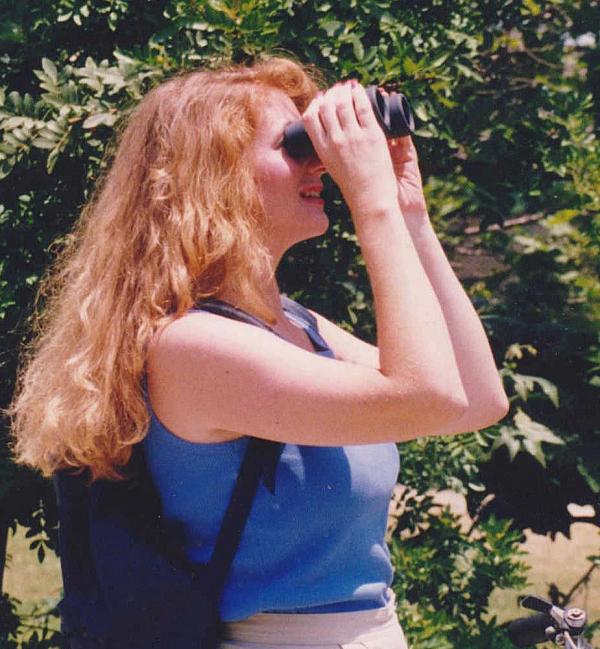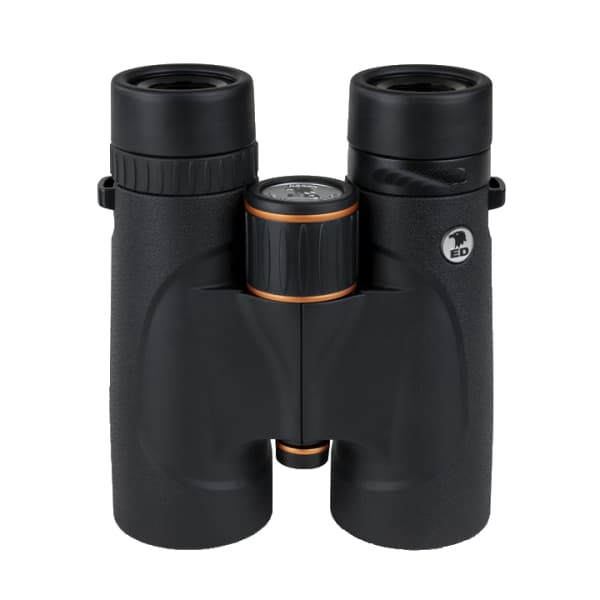
Primary considerations for birding binoculars are price, quality, size, and the overall feel of the binoculars when using them (photo by Paul Konrad).

Quality, well-balanced roof-style 8x42 binoculars are a standard for birding.
|
Binoculars are the most important equipment we need as birders, and when combined with a good field guide, you’re in vogue – ready to find and identify any bird that you encounter in the field, or that ventures into your yard or neighborhood. How are your binoculars treating you these days? As a means of answering that basic question, we thought it would be a good idea to take a very simple look at binoculars and to share what makes the biggest difference when selecting one model over others.
Certainly when we take a look at the broad range of binocular models on the market, and read the descriptions that optics companies provide, it can be daunting. But actually, when we select binoculars, there are really only a few ‘easy to assess’ variables you should keep in mind. So let’s keep this as simple as possible and hope these basic considerations help to provide a sound basis for selecting a binocular.
Price – As with any product we buy, be it a refrigerator, a car, or a binocular, the price tag may be the most important consideration as you shop. Like most products, with binoculars you get what you pay for as far as viewing quality goes; but for most birders there are limits to what you may be willing to pay for binoculars you primarily use from your picture window or outdoor deck. If you use the same pair of binoculars in the field, then their value to you tends to be greater, and you may be willing to spend a bit more – especially when you consider that binoculars tend to be a long-term investment.
We purchased our higher level binoculars in 1998, and they still fit the bill for all the binocular workouts we enjoy from the ocean shores to the highest mountains. Our home-based binocular is about 18 months old, more of a good quality beginner’s model, but they provide excellent views of birds outside our windows, at our feeding station, in our backyard landscaping that we often monitor from a comfy chair on our deck. So now we just realized our primary binoculars are 25 years old, and they still hold the same quality of optical magnification and views as day one. How much did we spend per year on those binoculars? About $40 per year, or a bit more than $3 per month; and we may use them another 25 years – a good investment indeed, which also makes us wonder how many birds and other animals we’ve viewed through these binos.
Quality – The binocular market is highly competitive, and anyone can be overwhelmed by the number and variety of models available. But because the optics market is so competitive, quality is balanced very closely by price – essentially, you get what you pay for. For us, quality if based on the view you see provided by the optics when looking through binoculars. Is the view sharp, clear, bright? Good optics improve the view your eyes see and in the case of using really good optics, it can be surprising how good your binocular view is.
Magnification – One of the most important considerations when selecting a binocular is magnification, after all that’s why we use binoculars, to get a closer look at a subject, a bird. But there are limits to how much you can magnify an object without distorting it. That limit is usually between 8-power (8x) magnification and 10-power (10x) magnification. Hence, we don’t suggest using more than an 8x magnification in a binocular. Using a higher magnification also magnifies the amount of bodily shake or movement that we all have, some more than others. A simple test will show you that you see a sharper image using 8x magnification than 10x, so we emphasize using 8x for all types of birding. If you want more magnification, it’s best to opt for a spotting scope with a sturdy tripod. The other negative about a 10x magnification is that it usually reduces the field of view of the binocular, making it harder to find a fast-moving warbler, or a duck in flight; it’s usually most helpful to have a broader field of view.
Full Size – While many beginners wish for the smallest, lightest binocular, that’s not practical for birding. Birders really need to use a full-size model that has 2 basic 42mm objective lenses – the big glass lenses at the end of the binocular, sometimes referred to as “objectives.” The number associated with each binocular, such as 8x42, is the magnification (8x) and the diameter of the objective lens (42mm). The 42mm objective lenses are very basic, and preferred by most birders because they help to provide a wider field of view.
Size, Weight, & Feel – Again, a full-size model is best all-around for birding, and for any other binocular endeavor. You quickly get used to the binoculars, and almost all binoculars are pared down to as light a weight as possible these days. Roof prism binoculars are preferred by most birders because they feel better in your hands. “Feel” is really an important aspect of selecting a binocular, and it’s always worthwhile to have a chance to handle a few models, just to experience what they feel like in your hands, while holding them to your eyes, while turning the focus wheel, even while holding the binoculars in one hand at your side as you walk. And keep in mind that you will quickly become very used to the feel of your binoculars, and they will become an intricate extension of your body when birding – using them will become second nature and you will always benefit from using good binoculars.
Frankly, there are a lot of other features that optics professionals will point out in their advertising and sales pitches, but the technical side of manufacturing binoculars is not all that important to the end user, as long as you are checking out quality binoculars from a quality-oriented company. Ultimately, it comes down to how do the views you see look, how do they compare with other models, and how they feel in your hands. You can spend a few hundred dollars, or a few thousand dollars, but it still comes down to the basics: The view you get and how comfortable they feel when you use them.
Some birders have one binocular they use in the field, and another at home; some prefer to use the same binocular wherever they go. (We actually have a third pair at the office.) When shopping for binoculars, it’s best to talk with someone who specializes in selling optics to birders. We suggest reviewing binoculars provided by a few national outlets online, thereby getting an idea of the range of binocular models available, including Optics4Birders and Land Sea & Sky. But at the same time, you will want to get your hands on a variety of models to really get a feel for each, as well as getting some good views through the optics of each model. That’s when attending a birding festival or a similar event where vendors will have a variety of binoculars on hand can be extremely helpful.
For now, to get started you can refer to Binoculars at Optics4Birding and ?????????? | Land Sea & Sky (landseaskyco.com)
We hope the above information provides some simple, basic information about how to evaluate the variety of binoculars available, and takes a lot of the technical descriptions of elements used to manufacture binoculars out of the equation. In the meantime, appreciate and enjoy your binoculars you are using now, and the birds you view with them during this exciting time of the year.
Share your backyard birding experiences and photos with The Birding Wire at editorstbw2@gmail.com